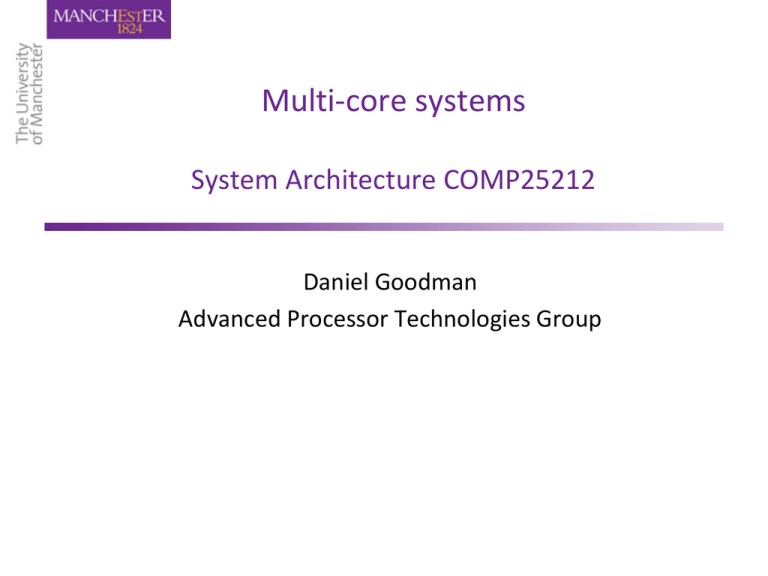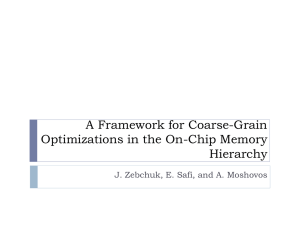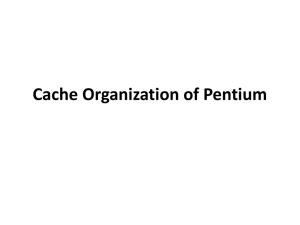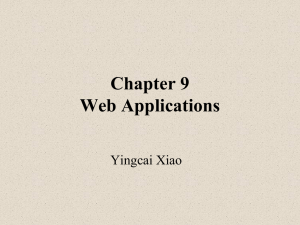Multicore 2
advertisement

Multi-core systems System Architecture COMP25212 Daniel Goodman Advanced Processor Technologies Group Intel Core i7 (Nehalem) 2 Simultaneous Multi-Threading per core Nehalem Caches Private L1: split D$ & I$, 32KB each, 4-way I$ & 8-way set associative, approx. LRU, block size 64 bytes, write-back & write-allocate Private L2: 8-way set associative. Shared L3: 16-way set associative AMD Shanghai Private L1: 2-way set associative, LRU replacement, block size 64 bytes, split I$ & D$, write-back & write-allocate, 3 cycles latency Private L2:. except 9 cycles latency and no split I$ & D$ L3: 48-way set associative and 29 cycles latency AMD Magny-cours Memory Coherence What is the coherence problem? • Core writes to a location in its L1 cache • Other L1 caches may hold shared copies - these will be immediately out of date The core may either • Write through to L2 cache and/or memory • Copy back only when cache line is rejected In either case we because each core may have its own copy, it is not sufficient just to update L2 and/or memory Snooping Protocols Schemes where every core knows which other core has a copy of its cached data are far too complex. So each core (cache system) ‘snoops’ (i.e. watches continually) for activity concerned with data addresses which it has cached. This has normally been implemented with a bus structure which is ‘global’, i.e. all communication can be seen by all Snooping Protocols can be implemented without a bus, but for simplicity the next slides assume a shared bus. There are ‘directory based’ coherence schemes but we will not consider them this year. Snooping Protocols Write Invalidate 1. A core wanting to write to an address, grabs a bus cycle and sends a ‘write invalidate’ message which contains the address 2. All snooping caches invalidate their copy of appropriate cache line 3. The core writes to its cached copy (assume for now that it also writes through to memory) 4. Any shared read in other cores will now miss in cache and re-fetch the new data. Snooping Protocols Write Update 1. A core wanting to write grabs bus cycle and broadcasts address & new data as it updates its own copy 2. All snooping caches update their copy Note that in both schemes, the problem of simultaneous writes is taken care of by bus arbitration - only one core can use the bus at any one time. Update or Invalidate? Update looks the simplest, most obvious and fastest, but:• Multiple writes to the same word (no intervening read) need only one invalidate message but would require an update for each • Writes to same block in (usual) multi-word cache block require only one invalidate but would require multiple updates. Update or Invalidate? Due to both spatial and temporal locality, the previous cases occur often. Bus bandwidth is a precious commodity in shared memory multi-cores chips Experience has shown that invalidate protocols use significantly less bandwidth. We will only consider implementation details only of the invalidate protocols. Implementation Issues In both schemes, knowing if a cached value is not shared (no copies in another cache) can avoid sending any messages. Invalidate description assumed that a cache value update was written through to memory. If we used a ‘copy back’ scheme (usual for high performance) other cores could re-fetch incorrect old value on a cache miss. We need a protocol to handle all this. MESI Protocol (1) A practical multi-core invalidate protocol which attempts to minimize bus usage. Allows usage of a ‘copy back’ scheme - i.e. L2/main memory is not updated until a ‘dirty’ cache line is displaced Extension of the usual cache tags, i.e. invalid tag and ‘dirty’ tag in normal copy back cache. To make the description simpler, we will ignore L2 cache and treat L2/main memory as a single main memory unit MESI Protocol (2) Any cache line can be in one of 4 states (2 bits) Modified – The cache line has been modified and is different from main memory – This is the only cached copy. (cf. ‘dirty’) Exclusive – The cache line is the same as main memory and is the only cached copy Shared - Same value as main memory but copies may exist in other caches. Invalid - Line data is not valid (as in simple cache) MESI Protocol (3) Cache line state changes are a function of memory access events. Events may be either • Due to local core activity (i.e. cache access) • Due to bus activity - as a result of snooping Each cache line has its own state affected only if the address matches MESI Protocol (4) Operation can be described informally by looking at actions in a local core • • • • Read Hit Read Miss Write Hit Write Miss More formally by a state transition diagram (later) MESI Local Read Hit The line must be in one of MES This must be the correct local value (if M it must have been modified locally) Simply return value No state change MESI Local Read Miss (1) A core makes read request to main memory One cache has an E copy • • • • The snooping cache puts copy the value on the bus The memory access is abandoned The local core caches the value Both lines are set to S No other copy in caches • The core waits for a memory response • The value is stored in the cache and marked E MESI Local Read Miss (2) Several caches have a copy (S) • • • • One cache puts copy value on the bus (arbitrated) The memory access is abandoned The local core caches the value and sets the tag to S Other copies remain S MESI Local Read Miss (3) One cache has M copy • • • • • The snooping cache puts it copy of the value on the bus The memory access is abandoned The local core caches the value and sets the tag to S The source (M) value is copied back to memory The source value changes its tag from M to S MESI Local Write Hit (1) Line must be one of MES M • line is exclusive and already ‘dirty’ • Update local cache value • no state change E • Update local cache value • Change E to M S • • • • Core broadcasts an invalidate on bus Snooping cores with an S copy change S to I The local cache value is updated The local state changes from S to M MESI Local Write Miss (1) Detailed action depends on copies in other cores No other copies • Local copy state set to M Other copies, either one in state E or more in state S • Value read from memory to local cache - bus transaction marked RWITM (read with intent to modify) • The snooping cores see this and set their tags to I • The local copy is updated and sets the tag to M MESI Local Write Miss (2) Another copy in state M Core issues bus transaction marked RWITM The snooping core sees this • • • • Blocks the RWITM request Takes control of the bus Writes back its copy to memory Sets its copy state to I The original local core re-issues RWITM request This is now simply a no-copy case • Value read from memory to local cache • Local copy value updated • Local copy state set to M MESI Local Write Miss (2) Another copy in state M Core issues bus transaction marked RWITM The snooping core sees this • • • • Blocks the RWITM request Takes control of the bus Writes back its copy to memory Sets its copy state to I The original local core re-issues RWITM request This is now simply a no-copy case • Value read from memory to local cache • Local copy value updated • Local copy state set to M MESI - local cache view Invalid RWITM Read Miss(sh) Mem Read Mem Read Read Miss(ex) Write Miss Read Hit Modified Write Hit Write Hit Shared Read Hit Exclusive Read Hit Invalidate Write Hit = bus transaction MESI - snooping cache view Mem Read Invalidate Invalid Shared Mem Read RWITM Modified Mem Read Invalidate Exclusive = copy back Comments on MESI Protocol Relies on global view of all memory activity – usually implies a global bus Bus is a limited shared resource As number of cores increases • Demands on bus bandwidth increase – more total memory activity • The bus gets slower due to increased capacitive load General consensus is that bus-based systems cannot be extended beyond a small number (8 or 16?) cores MOESI Protocol Modified • cache line has been modified and is different from main memory - is the only cached copy. (cf. ‘dirty’) Owned • cache line has been modified and is different from main memory – there are cached copies in shared state Exclusive • cache line is the same as main memory and is the only cached copy Shared • either same as main memory but copies may exist in other caches, or • Different as main memory and there is one cache copy in Owned state Invalid • Line data is not valid (as in simple cache) MESIF Protocol Modified • cache line has been modified, is different from main memory - is the only cached copy. (cf. ‘dirty’) Exclusive • cache line is the same as main memory and is the only cached copy Shared • same as main memory but copies may exist in other caches. Invalid • Line data is not valid (as in simple cache) Forward • cache line same as main memory but copies may exist in other caches. This cache is responsible to respond to requests (read and writes) for this cache line Reads and Writes to different words False sharing Summary Cache coherence: problem due to independent caches • need to minimize messages favours invalidate protocols • Snooping protocols - A family of protocols based around snooping write operations - MESI protocol, each cache line has a set of states Modified Exclusive Shared Invalid For further reading Patterson and Hennessy 4th Edition Sections 5.7, 5.8, 7.2 and 7.3











